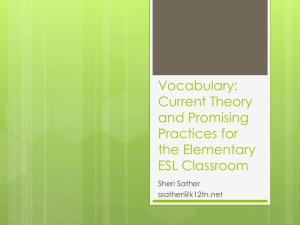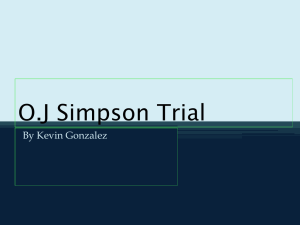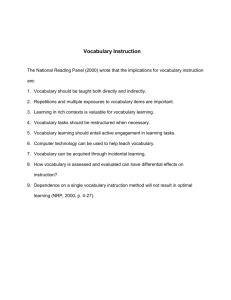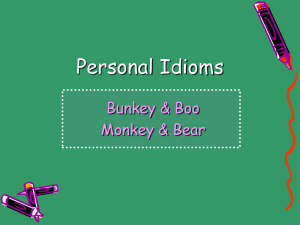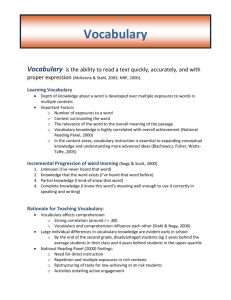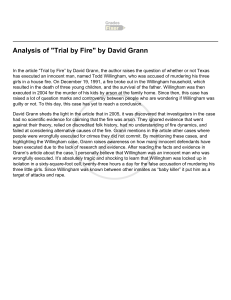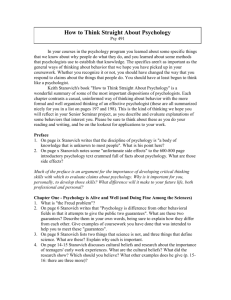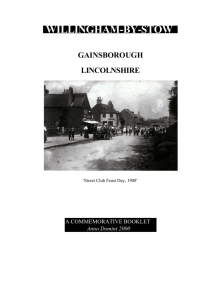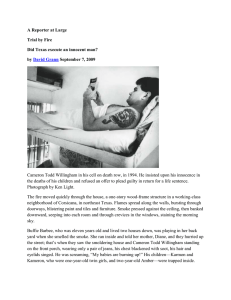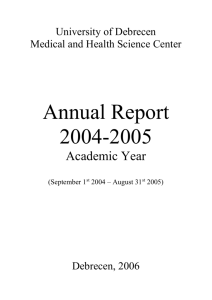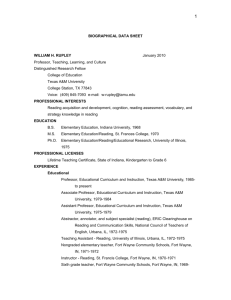PicchiRichekNADE2015.handout
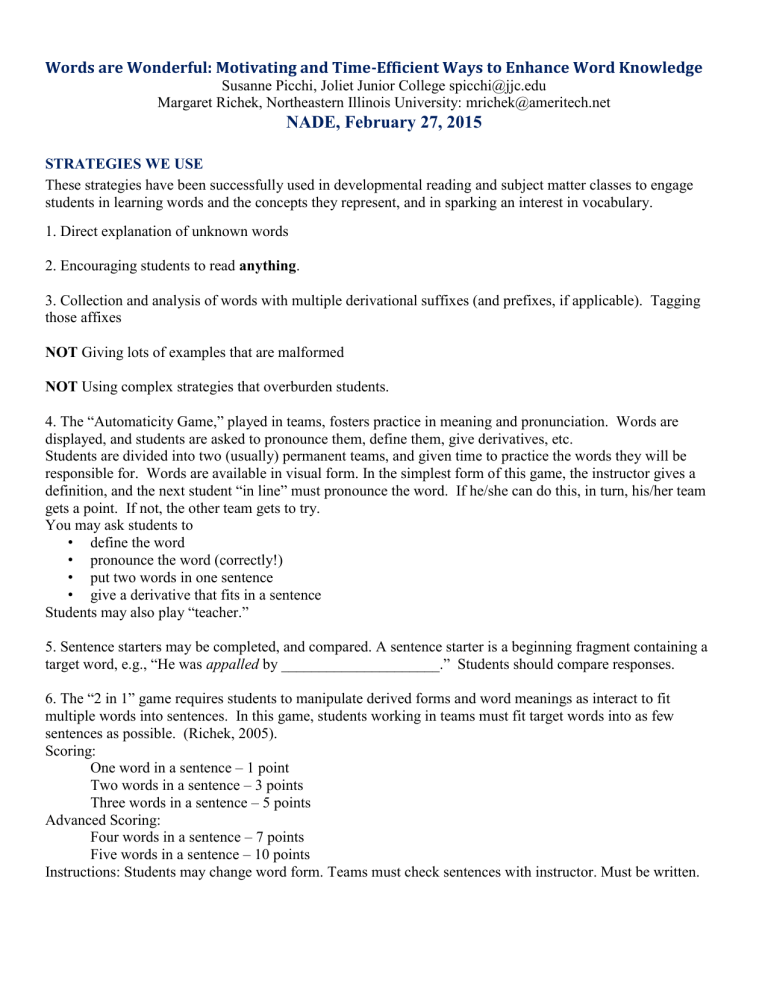
Words are Wonderful: Motivating and Time-Efficient Ways to Enhance Word Knowledge
Susanne Picchi, Joliet Junior College spicchi@jjc.edu
Margaret Richek, Northeastern Illinois University: mrichek@ameritech.net
NADE, February 27, 2015
STRATEGIES WE USE
These strategies have been successfully used in developmental reading and subject matter classes to engage students in learning words and the concepts they represent, and in sparking an interest in vocabulary.
1. Direct explanation of unknown words
2. Encouraging students to read anything .
3. Collection and analysis of words with multiple derivational suffixes (and prefixes, if applicable). Tagging those affixes
NOT Giving lots of examples that are malformed
NOT Using complex strategies that overburden students.
4. The “Automaticity Game,” played in teams, fosters practice in meaning and pronunciation. Words are displayed, and students are asked to pronounce them, define them, give derivatives, etc.
Students are divided into two (usually) permanent teams, and given time to practice the words they will be responsible for. Words are available in visual form. In the simplest form of this game, the instructor gives a definition, and the next student “in line” must pronounce the word. If he/she can do this, in turn, his/her team gets a point. If not, the other team gets to try.
You may ask students to
• define the word
• pronounce the word (correctly!)
• put two words in one sentence
• give a derivative that fits in a sentence
Students may also play “teacher.”
5. Sentence starters may be completed, and compared. A sentence starter is a beginning fragment containing a target word, e.g., “He was appalled by _____________________.” Students should compare responses.
6. The “2 in 1” game requires students to manipulate derived forms and word meanings as interact to fit multiple words into sentences. In this game, students working in teams must fit target words into as few sentences as possible. (Richek, 2005).
Scoring:
One word in a sentence – 1 point
Two words in a sentence – 3 points
Three words in a sentence – 5 points
Advanced Scoring:
Four words in a sentence – 7 points
Five words in a sentence – 10 points
Instructions: Students may change word form. Teams must check sentences with instructor. Must be written.
7. “Connect 2,” done independently or in class, fosters higher-level thinking and connections between words.
In this, words are listed in two columns, and students must find connect a word in column one with a word in column two, and defend that connection . (Blachowicz, and Lee, 1991). cliché
sparse synopsis bravado
concur
nadir contemporary synthesis discord inadvertently disseminate gregarious concur collaborate zenith cuisine synchronize coherent
Types of connections
They are the same in some way.
They are opposites in some way.
They have prefixes, suffixes.
They are the same part of speech.
They are positive/negative in some way.
They are members of the same category.
They both describe _________.
8. Word expert cards allow students to “own” words. Each student makes cards for a few words and then teaches these words to the others. The cards include graphic representations, as well as more standard information (definitions). The cards are made of a folded piece of card stock paper.
•
Each student is assigned a few words
•
He or she creates a card with the word and visual representation on outside the definition, part of speech, sentence inside
•
Students teach each other the words.
•
Used as a review in class; no more than 15 minutes
9. Looking at vocabulary in the wider world
Finding suffixes
Creating a growing list of idioms/words (animal idioms, body idioms, food idioms, foreign words)
Naming businesses
Sports headlines
Other topics: meanings of names, days of week, days of months, inventions (refrigerator, telescope, computer, microwave, etc.), cars, common foods, mythology
References:
Blachowicz, C.L.Z., & Lee, J. (1991). Vocabulary development in the whole literacy classroom. The Reading
Teacher , 45 , 188-195.
Richek, M.A. (2005). Words are wonderful: Interactive, time-efficient strategies to teach meaning vocabulary.
The Reading Teacher, 58, 414-423.
Richek, M.A. (2011). The world of words, 8 th Ed.
Boston: Wadsworth/Cengage.
A SUMMARY OF RESEARCH FINDINGS
Vocabulary is one of the best predictors of verbal academic achievement (Stahl, 1999; Daneman, 1991;
Francis and Simpson, 2009) and a critical component of reading instruction for developmental students
(Simpson & Randall, 2000). This reflects vocabulary’s role as an encapsulation of concepts and knowledge, as well as simply being a part of the content of reading material.
Obstacles faced to development of a well developed and academically servicable vocabulary include a lack of rich schema, often partially due to limited reading (Willingham and Price, 2009), a torrent of difficult reading material to be done independently (Willingham and Price, 2009), issues with comprehension (highly correlated with vocabulary, Rupley, 2005; Daneman, 1991; Willingham and
Price, 2009), lack of orientation to literary or technical reading, cumulative deficiencies in vocabulary exposure and language use (Hart and Risley, 1995), and challenges in life and language circumstances.
Suggested approaches include
encouraging reading (of just about anything), or exposure to written material
a combination of direct and indirect instruction
explicit instruction from comprehensible definitions (see Scott and Nagy, 1997 on definitions).
encouraging independent word learning, and strategies that foster this learning (dictionary use, context clues, morphemic analysis, Francis and Simpson, 2009).
igniting an interest in words, life and academic connections to words, and a comfort in their use.
adequate practice (including review) that will foster the full and flexible use of vocabulary.
References:
Beck, I.L., McKeown, M.G. & Kucan, L. Bringing words to life: Robust vocabulary instruction.
NY: Guilford, 2002.
Daneman, M. (1991). Individual differences in reading skills. In R. Barr, M. L. Kamil, P. Mosenthal, & P. D. Pearson (Eds.),
Handbook of reading research (Vol. 2, pp. 512–538). White Plains, N.Y: Longman.
Francis, M.A., & Simpson, M.L. (2009).Vocabulary Development. In R.F. Flippo and D.C. Caverly (Eds.) Handbook of
College Reading and Study Strategy Research 2 nd Ed.
(pp. 97-210). NY & London: Routledge.
Hayes, D.P., & Ahrens, M. (1988). Vocabulary simplification for children: A special case of ‘motherese.’ Journal of Child
Language , 15(2) , 572-585. (cited in West and Stanovich)
Hart, B. & Risley, T.R. (1995). Meaningful differences in the everyday experience of young American children. Baltimore,
MD: Brookes.
Nagy, W.E., & Anderson, R.C., & Herman, P.A.(1987). Learning word meanings from context during normal reading.
American Educational Research Journal , 24 (2), 237-70.
Nagy, W.E., Berninger, V.W. & Abbott, R.D. Contributions of morphology beyond phonology to literacy outcomes of upper
elementary and middle-school students. Journal of Educational Psychology , 98 (1), 134-147.
Rupley, W.H. (2005). Vocabulary instruction for the struggling reader. Reading & Writing Quarterly, 21 (3) , 203-207 .
Scott, J.A., & Nagy,W.E. (1997). Understanding the definitions of unfamiliar verbs. Reading Research Quarterly,32, 184-200
Simpson, M.L., & Randall, S.N. (2000). Vocabulary development at the college level. In R.F. Flippo & D.C. Caverly (Eds.),
Handbook of college reading and study strategy research, (pp. 43-73). Mahwah, NJ: Erlbaum .
Stahl, S. A. (1999). Vocabulary development . Reading research to practice , Vol. 2 (Ed. J. Chall). Cambridge, MA: Brookline.
Stahl, S.A., & Fairbanks, M.M. (1986). The effects of vocabulary instruction: A model-based meta-analysis. Journal of
Educational Research . 56 (1), 72-110.
Willingham, D. and Price, D. (2009) Theory to practice vocabulary instruction in community college developmental
education reading classes: what the research tells us. Journal of College Reading and Learning , 40 , 91-105.
West, R.F., K.E. Stanovich, and H.R. Mitchell. (1993). Reading in the real world and its correlates. Reading Research
Quarterly, 28 9 (1), 35–50.
West, R.F., K.E. Stanovich what reading does for the mind. American Educator , (The American Federation of Teachers)
22 (1–2), 8–15.
Susanne Picchi has used this assignment as a review for her final exam.
Vocabulary Poster Project Name: ________________________
Due date: __________ Point Value: ___________
As a way to make connections to the vocabulary words we are studying and to review for your final exam, you will select twenty- four words and a picture that represents each word to place on a poster. This poster will be used as a test for other students in the class.
Your poster will:
contain pictures of any twenty (20) words from the ten chapters we study this semester. Each picture should be a clear representation of the vocabulary word.
have a word bank of the 20 words you have chosen to represent.
be neat, legible, and easy to read. The use of color helps.
have all words spelled correctly.
be used as a test for other students in class to take so they can raise their grade.
have your name on the front side.
will need a test answer key.
You will grade and initial the papers of those who take your test.
Sample of YOUR POSTER
1. 2. 3. 4.
5. 6. 7. 8.
Vocabulary Test
Word Bank
